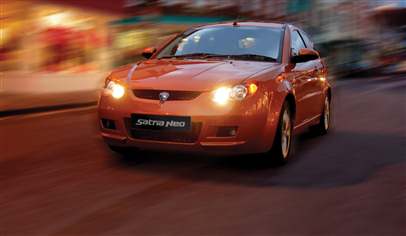



Insurance Group: 19
MPG: 42.8
CO2: 157
0-62 Mph: 11.5 secs
BHP: 111 BHP
Range: 424 miles

The amount of standard equipment offered will impress you but important safety features such as stability control and side airbags are missing. You may consider owning the car for longer, due to its steep depreciation rate.
PROS: Sharp steering. Standard equipment level is okay
CONS: Not refined. Loud engine. Cramped cabin. Some safety kit is missing. Driving position is too high. Short service interval. Poor residual value.
The Satria Neo has a 1.6-litre, 4-cylinder 16v 1597cc petrol engine. It produces 111bhp and torque figures of 109 lb-ft, but it does not feel strong enough. A 0-62mph time of 11.5 seconds falls within the class range and a top speed of 118mph ensures that it can keep up with traffic on the motorway.
Steering is light, sharp and responsive, making the Satria fun to drive. Suspension is stiff and helps in boosting the car’s handling. However, it is not firm enough to soak bumps and driving on poor roads will send jolts throughout the cabin.
The car is not refined: the engine drones endlessly and there is plenty of road and wind noise. All-round visibility is enhanced by small pillars and large windows.
The Satria is a 3-door, 5-seat small family hatchback. It is well designed and looks decent enough to make you a proud owner. The low, sloping roofline is particularly eye-catching and the bonnet has nice sporty look.
Proton has done a good job on the interior. Leather seats add to the overall sporty feel of the car and even though the dash and switchgear are rather plain, overall cabin quality is not too bad.
Sport trim misses some important features but the level of standard kit is still commendable. The car has power steering, central locking, alloy wheels, climate control, electric door mirrors, electric front windows, rear parking sensors, leather seats, driver airbag, passenger airbags, alarm, immobiliser and CD player.
Metallic paint is only cost option available and it costs £365.
Proton markets itself as a low-cost brand and it would be ambitious to expect premium-brand quality from them. But from behind the wheel, the Satria does not feel as well-built as the Kia Rio or Ford Fiesta. The car maker does not have a strong reputation for reliability either, but the 3-year warranty up to 60,000 miles is reassuring.
While the Satria has a good number of safety features, it does miss some crucial ones. Stability control, side airbags and deadlocks are unavailable. Worse, they are not offered as extras either. It is hard to say just how safe the Satria Sport is, as it is yet to undergo the Euro NCAP crash test.
The cabin is not very spacious, with the steep windscreen taking up part of the headroom. The sloping roofline means space is constricted at the rear too. Tall passengers will be uncomfortable during long drives. The seats are supportive and even though they are designed for five, only four can sit comfortably.
The driver’s seat is set high and will not suit everyone. You can lower the driving position by adjusting the seat height downwards, but there is a limit to how far you can set the seat. The steering wheel adjusts for height only, further limiting your chances of getting a good driving position.
There are enough cup holders in the cabin for your water and snacks. The glove box is a good size too and will hold a good number of small valuables. The boot has a capacity of 286 litres, which is within the class range. The space increases to 615 litres when you fold the seats.
The Satria Sport is affordable and does provide good value for money. But its performance is wanting in the face of worthy rivals such as the Volkswagen Up, Ford Fiesta and Suzuki Swift, which cost about the same. Proton models do not hold their value well, and sadly, this applies to the Satria Sport as well.
The Satria Sport is not the cheapest small family car to run. It only returns 42.8mpg in combined cycle, yet some competitors edge close to 50mpg. The car meets Euro 4 emission limits but its 157g/km average is still higher than that of most rivals. It sits in road tax band G, which will cost you £165 in VED a year.
Satria Sport is placed under insurance group 19, and insurance premiums are expected to be average. Unfortunately, the car has a short service interval. Visiting the service centre every 9,000 miles will significantly increase your expenses.
The Proton Satria Neo 1.6 GSX is the pick of the range, purely because it is the cheapest. However, there are cars out there for the same money which offer better handling, better build quality and...
The Proton Satria Neo 1.6 Sport has a sporty look and is engaging enough for a thrilling drive. Only average handling spoils the fun. It is not very spacious inside and will prove too limiting for ...
Proton’s Satria Neo Sport is a small hatchback with a good level of equipment and decent handling. Overall though, the Satria Neo Sport is disappointing. While it handles reasonably well - its inte...
You might want to read reviews for other Small Family cars that you can then compare to the Proton Satria. Here are some popular Proton Satria alternatives:














